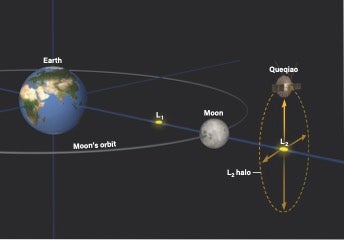The Queqiao satellite orbits around the L2 Lagrange point located behind Earth and the Moon to relay communications from China’s lunar landers back to Earth. How is it able to orbit that point if the gravitational forces there are balanced?
Lagrange points are locations around a two-body system where the gravitational forces of the two objects, in this case Earth and the Moon, are equal to the centrifugal force. This allows for a satellite to stay in place with relatively little motion at one of the five Lagrange locations. However, the gravitational forces for L1, L2, and L3 are only balanced well in one radial direction, meaning these points are unstable.
You can think of it like keeping a ball on your head. Your head will prevent the ball from falling straight to the ground, but it will quickly roll off to one side unless you balance it by moving around a little bit.
Similarly, in order for Queqiao to stay put at L2, it would need to have exactly the right velocity and location. However, it can easily drift away in a plane perpendicular to the imaginary line connecting Earth and the Moon. If the satellite gets slightly ahead of the Earth-Moon line, the Moon’s gravity pulls it back and slows it down. Conversely, when Queqiao starts to fall behind, the Moon will pull it forward and accelerate it again. This gravitational dance only requires slight adjustments from the craft’s thrusters to keep it roughly in orbit around L2.










